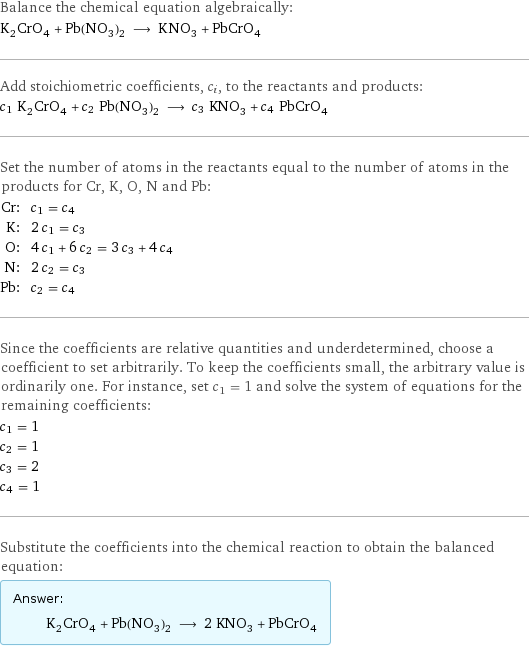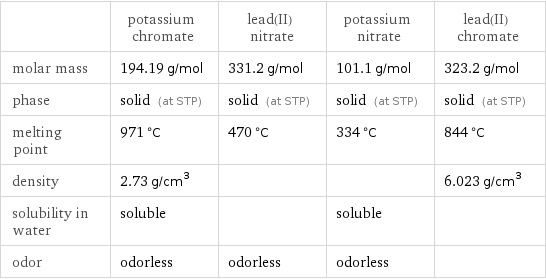Input interpretation

K_2CrO_4 (potassium chromate) + Pb(NO_3)_2 (lead(II) nitrate) ⟶ KNO_3 (potassium nitrate) + PbCrO_4 (lead(II) chromate)
Balanced equation

Balance the chemical equation algebraically: K_2CrO_4 + Pb(NO_3)_2 ⟶ KNO_3 + PbCrO_4 Add stoichiometric coefficients, c_i, to the reactants and products: c_1 K_2CrO_4 + c_2 Pb(NO_3)_2 ⟶ c_3 KNO_3 + c_4 PbCrO_4 Set the number of atoms in the reactants equal to the number of atoms in the products for Cr, K, O, N and Pb: Cr: | c_1 = c_4 K: | 2 c_1 = c_3 O: | 4 c_1 + 6 c_2 = 3 c_3 + 4 c_4 N: | 2 c_2 = c_3 Pb: | c_2 = c_4 Since the coefficients are relative quantities and underdetermined, choose a coefficient to set arbitrarily. To keep the coefficients small, the arbitrary value is ordinarily one. For instance, set c_1 = 1 and solve the system of equations for the remaining coefficients: c_1 = 1 c_2 = 1 c_3 = 2 c_4 = 1 Substitute the coefficients into the chemical reaction to obtain the balanced equation: Answer: | | K_2CrO_4 + Pb(NO_3)_2 ⟶ 2 KNO_3 + PbCrO_4
Structures

+ ⟶ +
Names

potassium chromate + lead(II) nitrate ⟶ potassium nitrate + lead(II) chromate
Equilibrium constant
![K_c = ([KNO3]^2 [PbCrO4])/([K2CrO4] [Pb(NO3)2])](../image_source/63ca20e374fe9b21d000d57e2b6350e1.png)
K_c = ([KNO3]^2 [PbCrO4])/([K2CrO4] [Pb(NO3)2])
Rate of reaction
![rate = -(Δ[K2CrO4])/(Δt) = -(Δ[Pb(NO3)2])/(Δt) = 1/2 (Δ[KNO3])/(Δt) = (Δ[PbCrO4])/(Δt) (assuming constant volume and no accumulation of intermediates or side products)](../image_source/e08d52a659d9e84ceada532c3f843704.png)
rate = -(Δ[K2CrO4])/(Δt) = -(Δ[Pb(NO3)2])/(Δt) = 1/2 (Δ[KNO3])/(Δt) = (Δ[PbCrO4])/(Δt) (assuming constant volume and no accumulation of intermediates or side products)
Chemical names and formulas

| potassium chromate | lead(II) nitrate | potassium nitrate | lead(II) chromate formula | K_2CrO_4 | Pb(NO_3)_2 | KNO_3 | PbCrO_4 Hill formula | CrK_2O_4 | N_2O_6Pb | KNO_3 | CrO_4Pb name | potassium chromate | lead(II) nitrate | potassium nitrate | lead(II) chromate IUPAC name | dipotassium dioxido-dioxochromium | plumbous dinitrate | potassium nitrate | plumbous dioxido-dioxochromium
Substance properties

| potassium chromate | lead(II) nitrate | potassium nitrate | lead(II) chromate molar mass | 194.19 g/mol | 331.2 g/mol | 101.1 g/mol | 323.2 g/mol phase | solid (at STP) | solid (at STP) | solid (at STP) | solid (at STP) melting point | 971 °C | 470 °C | 334 °C | 844 °C density | 2.73 g/cm^3 | | | 6.023 g/cm^3 solubility in water | soluble | | soluble | odor | odorless | odorless | odorless |
Units
